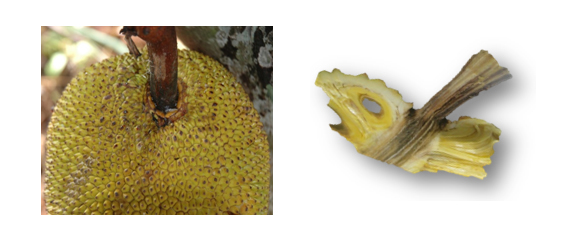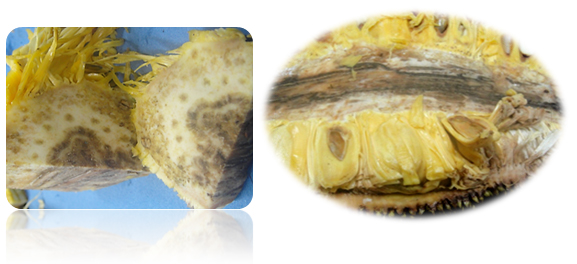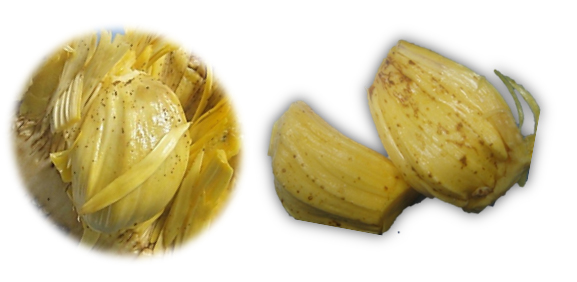The urban consumer preference for convenience and prepared food has prompted interest in the promotion and production of minimally processed items for fruits, roots and vegetables.
Minimal processed fruits involve separation of the edible portion of the fruits and packing them in ‘ready to eat’ packages under hygienic and refrigerated conditions.
Due to handling inconvenience because of its large size and presence of latex in the fruit , jackfruit or Artocarpus heterophyllus has been a popular fruit for the minimum processed market. It has a big potential for the export market because of the increasing demand for quality and safe tropical fruits, convenience packaging, and minimum requirements for Sanitary and Phytosanitary (SPS) regulations from importing countries.
Fruit quality is dependent on the condition of the ‘bulbs’ or ‘flesh’ (seeded arils or fully developed perianths). Good quality jackfruit favoured for minimum processing is normally sweet with a thick rind and deep yellow in color. The sweeter varieties command a better price.
Recently there have been numerous reports of rust coloured specks or streaks appearing on the ‘flesh’ of the fruit. In the advance stage, the specks coalesce and cause the ‘flesh’ to rot. This condition affects the eating quality of the fruits due to its unpleasant taste. The other observed symptoms are:
- Browning and rotting at external fruit surface (advanced infection)
- Rot may be visible at base of peduncle
- Brown discoloration along peduncle to fruit central core
- In the advance stages, brown spots also occur on the unseeded arils (perigones)
This situation, if not checked can seriously thwart efforts to enhance market access for minimal processed jackfruit.

Plate 1. Symptoms of fruit rot on fruit surface (Courtesy: Dept. of Agriculture, Malaysia)
Plate 2. Fruit rot on base and inside of peduncle (Courtesy: Dept. of Agriculture, Malaysia)
Plate 3. Browning in fruit center core (Courtesy: Dept. of Agriculture, Malaysia)
Plate 4. Brown specks that will later coalesce to cause ‘flesh’ rot (Courtesy: Dept. of Agriculture, Malaysia)
Some observations and reports on the occurrence of this condition are:
- Most are observed to occur after or during the rainy season, where humidity is relatively high
- Symptoms appear more in ‘stressed’ plants as a result of nutrition imbalances, soil types and terrain conditions and injury.
- Healthier trees are more tolerant
- The condition is found in all fruits showing initial or advanced external symptoms such as dark rot spots and the presence of mycelia or spores.
- The symptoms may also appear in fruit which do not exhibit any external symptoms on the fruit surface.
- Initial symptoms can be identified by brown discoloration when the fruit stem or peduncle is cut.
- The condition is found in specific varieties, especially the sweet varieties with high brix content in the fruit.
- An inconsistent pattern of incidences, where fruits on a tree affected this season may not be affected the next season. This confirms that incidences are weather related.
- Studies by the Department of Agriculture, Malaysia indicate that the condition is related to a fungal disease – Fruit Rot of Jackfruit. The causal agents identified are Rhizopus artocarpi and Lasiodiplodia sp.
- Initial treatment with proxylactic sprays using Copper Oxychloride seems to reduce disease incidence.
The occurrence of this condition is believed to be caused by a combination of abiotic factors such as weather, soil types, terrain and plant nutrition which affects plant health, and a fungal pathogen. The pathogen identified to cause infection is Rhizopus artocarpi is a ‘Cosmopolitan’ fungus that is ubiquitous and universally identified as a causal agent which infects male flowers and fruits through injury, causing fruit rot. Another pathogen, Lasiodiplodia sp, a latent fungus also contributes to this condition. Generally interplay of plant health, abiotic conditions and the presence of these pathogens causes this malady.
Mitigation measures include:
- Continuous monitoring of the incidence in commercial growing areas. Monitor disease incidences by checking on symptoms on the male inflorescence and internal fruit symptoms by inspecting the peduncle.
- Prophylactic sprays using Copper Oxychloride especially during the rainy season.
- Cultural methods including pruning of low branches, restricting number of fruits, getting rid of infected male inflorescence, disinfecting wrapping bags, avoiding injury to developing fruits, and destroying diseased fruits.
- Practice mixed cropping with other fruit types.
- Consider other less susceptible varieties for commercial planting.
Readers of this article are requested to provide inputs if they have experienced similar incidences. Please respond to info@itfnet.org
Article summarized by TFNet from presentations by DOA Malaysia and Malaysian Agricultural Research and Development Institute during a technical review on 18 September 2012.




I have allready solved this problem using liquid fertilizer FTI7
call Azmi 0179918699